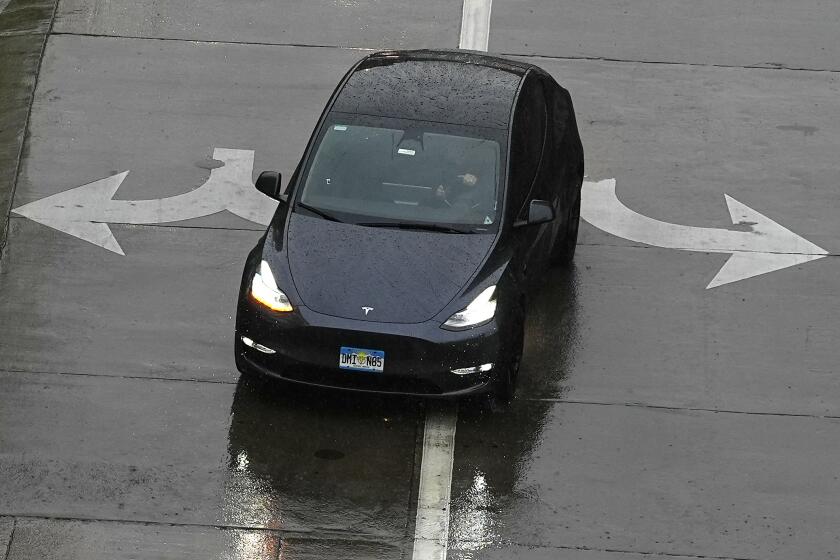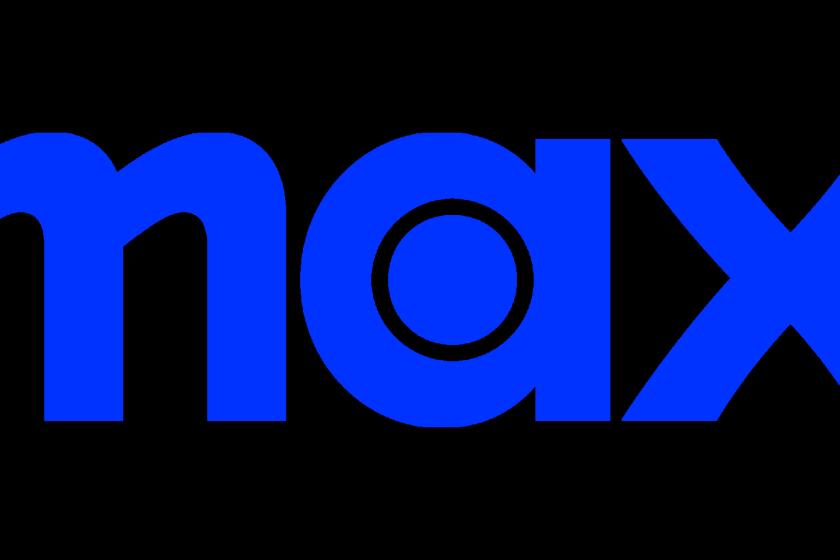Facing skepticism, Elon Musk unveils prototype for driverless robotaxi

- Share via
- Tesla Chief Executive Elon Musk unveiled prototypes of a self-driving taxi and van that he said would revolutionize travel and claimed the electric car company would put fully autonomous vehicles on the road by next year.
- While some viewed the event as a proof of concept for Musk’s Cybercab, others were far more skeptical.
- Tesla has banked its future largely on the expectation that it will overtake competitors to dominate the burgeoning robotaxi market.
Tesla Chief Executive Elon Musk presented a lofty vision for the future Thursday night, unveiling prototypes of a self-driving taxi and van that he said would revolutionize travel and claiming the electric car company would put fully autonomous vehicles on the road by next year.
At an event on the Warner Bros. Studios lot in Burbank, Musk rolled out examples of what he dubbed the Cybercab. The futuristic, metallic silver vehicles lacked steering wheels, pedals and rearview mirrors. Invited guests took short rides around the studio’s closed roads.
A lot is riding on the Cybercab for Musk, who has been selling unfulfilled promises of autonomous vehicles for years. Although Tesla’s sales of its signature electric cars stumbled early in 2024, the company has an $800-billion market capitalization built largely on the expectation that it will be able to overtake competitors to dominate the burgeoning robotaxi market. Whether Tesla is anywhere close to completing its push to develop the technology needed to do so, however, remains an open question.
On Friday, investors signaled they were skeptical of Musk’s latest claims. At 10:55 a.m Pacific time, shares of Tesla stock were trading at about $219.50, down 8% on the day.
“Investors have clearly been very excited about this for many years even though Tesla hasn’t delivered on it,” said Sam Abuelsamid, a transportation analyst at Guidehouse Insights.
“Tesla’s valuation is much higher relative to their revenues and their profits and that is almost entirely based on the presumption that they will suddenly start generating mountains of new profits,” he said.
After years of rapid growth, electric vehicle sales in California went flat in the middle of last year and are now in decline.
Musk also unveiled the Robovan on Thursday night, a self-driving vehicle that can transport goods or up to 20 people. And he topped off his highly produced event with a demonstration of a humanoid robot named Optimus, several of which performed dance moves for the crowd or served drinks.
The event, which the company called “We, Robot,” made clear that Musk has ambitions for the future that go beyond transportation. Speaking to the invite-only crowd and those watching online, he conjured up a world where every family has an Optimus robot capable of doing the grocery shopping, babysitting and watering the plants. The automated labor, he said, would make goods and services less expensive and more accessible.
“It will be an age of abundance, the likes of which almost no one has envisioned,” Musk told the crowd.
While some viewed the event as a proof of concept for Musk’s robotaxi, others were far more skeptical, saying it was all show and no substance.
“Having a prototype vehicle says nothing about whether a company has developed the hardware and software necessary to safely operate that vehicle without a human driver,” said Bryant Walker Smith, an associate professor of law at the University of South Carolina who specializes in emerging transportation technology.
Testing the Cybercab on closed roads is one thing, while being able to produce one that is able to safely navigate real roads is something altogether different, Smith said.
Musk said the Cybercab would be in production no later than 2027 and would be available for purchase for about $30,000. He did not specify whether the Cybercab would rely on Tesla’s so-called Full Self-Driving technology, or FSD, which is already deployed in many Teslas on the road but is not capable of operating without a driver present.
“When we think about transport today, there’s a lot of pain that we think is normal, like having to drive around L.A. in three hours of traffic,” Musk said Thursday. “With autonomy, you get your time back,” he said.
It was a familiar promise from Musk, who has claimed repeatedly since 2014 that Tesla was nearly ready to launch fully autonomous vehicles.
Musk has come under criticism for his claims about the capabilities of FSD, which the company has been selling to customers for thousands of dollars since 2020. The tech is currently dubbed FSD Supervised because it requires an alert, human driver to be behind the wheel during operation.
Tesla posted its first quarterly increase in vehicle sales this year, but shares fell as delivery numbers came up short of investor expectations.
“The Model S and Model X at this point can drive autonomously with greater safety than a person, right now,” Musk said in 2016, according to a clip that some say has been altered. Tesla’s self-driving feature cannot be used without someone in the driver’s seat and has been linked to several accidents, including fatal crashes.
In May, a Tesla in FSD mode nearly hit a moving train after failing to detect the locomotive. The driver hit the brakes himself and accepted responsibility for the accident, but told NBC News he believes FSD is a defective product.
“Tesla has said that a human driver needs to be more attentive, not less attentive, when using this feature,” Smith said of FSD. “Yet it is the very system that the Tesla CEO has for many years indicated would be imminently capable of automated driving.”
In addition to the robotaxi unveiled Thursday night, Musk spoke of his vision for an ad hoc taxi service, in which owners of Tesla vehicles equipped with FSD would be able to deploy them to pick up paying customers.
Musk said FSD capable of this unsupervised driving would be available to owners of Tesla’s Model 3 and Model Y vehicles in Texas and California by next year.
“I think this is a historical event, the most important that Tesla has done in the last decade,” said Dan Ives, an equity analyst at Wedbush Securities. “Many of the skeptics never thought Tesla was going to get electric vehicles on the road,” he said.
Tesla’s robotaxi business could create $10 billion to $15 billion in annual revenue for the company, Ives projected.
Tesla’s share price has risen nearly 40% over the last six months amid anticipation that the company would soon create a fleet of robotaxis and develop artificial intelligence that would enable fully autonomous driving.
Waymo, the autonomous taxi service owned by Alphabet Inc., already has self-driving cars on the road in Los Angeles and San Francisco. In both cities, Waymo vehicles are completing trips for real customers without a driver present.
Even without drivers, autonomous taxis have expenses, such as charging, cleaning and insurance, which eat into profits.
“No one has really yet figured out a business model for robotaxis,” Abuelsamid said.
Waymo cars use laser-based sensors known as Lidar to perceive the surrounding environment and make autonomous driving possible. Musk has dismissed Lidar as unnecessary and too expensive, but has so far been unable to achieve autonomous driving with alternate technology that relies instead on cameras to take in a vehicle’s surroundings.
“Elon Musk has been quite clear that he doesn’t believe that radar and Lidar are needed and that they can do it with cameras alone,” Abuelsamid said. “So far to date, no one has actually demonstrated that that is a sufficiently safe and viable solution.”
Despite optimistic investors and rising share prices in recent months, Tesla’s sales have slumped, with the company on track to record its first annual vehicle sales decline. The company delivered 462,890 vehicles in the third quarter, missing some analysts’ estimates but marking the first quarterly increase in sales this year. Tesla also slashed roughly 10% of its global workforce in April.
Increased competition in the electric vehicle space has squeezed Tesla’s sales even as the company attempts to appeal to more customers with price cuts and offers of free charging. Startup electric vehicle makers such as Rivian are offering customers other products, while traditional auto manufacturers such as Hyundai and Ford have also released lines of electric options.
Although consumers have options, concerns over driving range and charging time have contributed to faltering sales of electric vehicles in California. Electric vehicle sales are down in the state after years of growth, a trend that has hit Tesla particularly hard.
Musk has set expectations high for his company, and with the Cybercab he is trying to shed a reputation that he makes empty promises. Abuelsamid is doubtful that Tesla will actually deliver on the technology showcased Thursday night in the near future, he said.
“It’s Tesla, it’s Elon Musk, it’s obviously going to be a hype fest,” he said.
More to Read
Inside the business of entertainment
The Wide Shot brings you news, analysis and insights on everything from streaming wars to production — and what it all means for the future.
You may occasionally receive promotional content from the Los Angeles Times.













